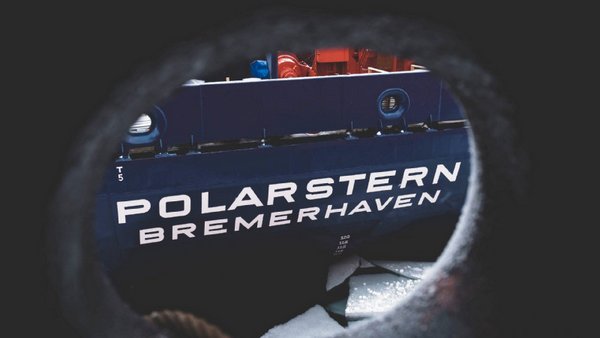
Foto: Jan Rohde, AWI

12 October 2020 (online)
Welcome back, Polarstern!
Polarstern returns to Bremerhaven after the one-year MOSAiC expedition in the Arctic. On Monday, 12 October, the return of the icebreaker will be streamed live from the Alfred Wegener Institute from about 7:15 am. In addition, the AWI will report on various social media channels under the hashtag #welcomePolarstern: https://www.awi.de/im-fokus/mosaic-expedition/livestream.html

Foto: Jan Rohde, AWI
10 October 2020 (N 58°39’, E 04°09’, west of Norway)
Last report before returning home
Dear all,
we are on our way home and will arrive coming Monday (12 October 2020) at Bremerhaven. It was/is and will likely be a very smooth going through the different seas (Greenland, Norwegian, North).
This arrival is not a standard arrival. It’s an arrival after one year in the central Arctic. It’s an arrival of the crew and the scientists of Leg5 of the MOSAiC campaign. But, its indirectly also an arrival of the efforts of much more people. I would like to include especially the former participants of the MOSAiC campaign that run the systems I had to run: Ronny, Hannes, Martin, and Julian. They did a great job and I just have/had to continue their work.
We got a lot of data. I hope that we will have the opportunity to evaluate all the wonderful data. Especially, I think about the freezing and melting at “our” (Leg5) floe 2.0. We had different atmospheric conditions: cold air advection, warm air advection, decreasing sun elevation angles (changing radiation), lofted aerosol layer, different cloud developments, and so on. I think also about our transits through the ice edge, with stations in the ice area and then going forth and back (out of the ice and back to the ice).
MOSAiC is the abbreviation for “Multidisciplinary Drifting Observatory of the Study of Arctic Climate”. This is represented also in the 5 scientific teams on board: ATMOS, ICE, OCEAN, ECO, BGC. Scientist from different disciplines were working together looking from the space downward or from some meters above the sea floor upward with their different techniques and objects of interest on the different scales, cycles, forces, energies, fluxes, living, and non-living matter, waters, temperatures, salinities, sea ice, atmosphere, …
The next goal is to bring together the puzzle pieces to understand a bit more the Artic and its internal behavior and possible its influences on our life and our contributions to its comportments in future. Let’s hope that we get supported for this.
I wish you all the best and please, keep well!
Best greetings
Dietrich
22 September 2020 (N 86°28’, E 94°40’)
Farewell to the ice floe 2.0.
Dear all,
the day before yesterday was a special day. It was the day 366 of the MOSAiC experiment (birthday). On 20 September 2019, the Polarstern had left Tromsø. And additionally, one year later we have left the floe 2.0.
The two days (18 – 19 September 2020) before were used for the dismounting, packing, and bringing on board of all the instruments.
On 20 September 2020 a floelympics was planned at 1 p.m. But the floelympics were cancelled due to 2 polar bears around. The group photo and a Glühwein at the floe did be possible at 3 p.m. The end of the Glühwein was determined again by a polar bear. This guy wanted to say good bye to us personally, too. So, he/she went into “our” area. We went on board right in time, all worked very well. The polar bear guards realized him/her very early in advance or had several eyes on him/her already all the time, respectively, and even we could see him/her also in advance. Anyhow, it was almost the time to go. Finally, all things are removed and the masters of this area (the polar bears) and all the other animals and plants took over the area as their domicile as it had been before. Aside: we never interfered with the polar bears. When they came we removed ourselves always.
What happened else?
We had “the open container” at 20:00LT on Wednesday, 16 September 2020. It was a good and successful event. I prepared several slides, printed these slides, and was well prepared by this. The interest was great, I could show our systems and the ideas behind to many people.
Sunrise, sunset:
At the floe, the sun got lower and lower, but we didn’t have a sunset there. The sun got over the horizon at maximum 3° when we started to go back to the South. So, the afternoon and the night were a bit like a German late afternoon. Now, we are more South and yesterday we had our first sunset since weeks. But, due to clouds we couldn’t see this sunset … it was a more theoretically sunset. But, today the sunset was so wonderful, beautiful, amazing, … that’s why I’m adding a sunset photo to this report. This photo was taken at the working deck during a short station.
Low elevation angles of the sun at the floe:
As the sun was so low at the floe, it was interesting to see the dark reflections of the leads to the foggy sky. I learnt for this time of the year: “where you can see dark structures at the sky … there is/might be water accessible/below”. Isn’t it interesting? …
Plans for the next time:
We were told that the Polarstern will arrive at Isfjord/Svalbard on 2 October 2020. Then, the rifles and other polar bear safety things will be given back in Ny-Aalesund. We will leave Svalbard on 4 October since it takes about 6 days to Bremerhaven (+2 days for reserve in case of bad weather conditions). The arrival of the Polarstern is planned for 12 October 2020.
But first, let’s see how fast we can move through the ice. At the moment it seems to be easier than the expectations. This could yield to some more scientific stations on our trip. Especially, the ice edge could be an interesting area. Let’s see.
Have a good time and please, keep well.
Best greetings
Dietrich
31 August 2020 (N51°20, E12°23)
"Ein Jahr im Eis" (in German)
For the largest Arctic expedition of all times, Polarstern has been drifting in the Arctic Ocean for months. How does it research surrounded by plaice and polar bears? A conversation. (in German)
"Leibniz" - the magazine of the Leibniz Association - spoke in cooperation with the podcast radio detector.fm - about the mammoth expedition, life on board and polar bear visits on cold polar nights with Martin Radenz and Andreas Macke from TROPOS:
https://www.leibniz-magazin.de/alle-artikel/magazindetail/detail/ein-jahr-im-eis.html
09 September 2020 (N78°15, E15°28)
Measuring flights in full swing
The Arctic measurement campaign with research aircraft is ongoing: The scientific flights will be used for research into the atmosphere and sea ice and will complement the extensive programme of the MOSAiC expedition. Researchers from Leipzig are also on board.
For more information, visit the Leipzig University at https://www.uni-leipzig.de/newsdetail/artikel/messfluege-in-vollem-gange-2020-09-09/ , the Sächsische Zeitung https://www.saechsische.de/wirtschaft/umwelt/endlich-uebers-polar-eis-5268862-plus.html and Youtube https://www.youtube.com/watch?v=K0cXMN_q7W4&feature=youtu.be
06 September 2020 (N 88°45’, E 116°34’)
Storms could change our world.
Dear all,
here, my next report from our station at the ice floe 2.0. At the moment, we are at about 88.757°N, 116.565°E.
This morning, we had calm weather. Hence – for the first time at the floe 2.0 - the helicopter was able to fly more than 400 m away from the Polarstern.
Now, we are expecting snow and wind speeds with 5-6 Bft (10 – 12 m/s) and gusts of up to 7-8 Bft. Let me call this event an EVENT WITH FASTER WINDS AND SNOW.
Anyhow, all are aware that the floe may break and “something” could happen. Hence, our todays work was to bring out generators to the Met city. Hopefully, they will not be necessary.
In our Oceanet container, everything seems to run fine. The sun photometer may have some problems, but I’m not even able to check this since we didn’t have any cloud-free and fog-free day during leg5 so far.
I’m checking daily all the systems, I’m happy that everything runs fine, and I’m supporting other scientists: helping at transports of systems from the ship to Met city and around and doing bridge watches (lookout for polar bears).
Storms could change our world. The ocean people think about the vertical structure. In “our” region, there is Arctic Ocean water on top, below Atlantic water, and the lowest “layer” is again Arctic Ocean water. The temperature of the Arctic Ocean water is below 0°C while the top of the Atlantic water is about 1°C warm. It is thought that a storm could cause a vertical mixing of Atlantic water to the sea surface. This would have a dramatic impact on the sea ice. It would not survive.
Also, snow could change our freezing world. At the moment, we are at this transition stage to freezing. All is fragile and depending on the energy and “molecule” budget at the surface. Snow did already and will change the albedo of the melt ponds, leads, and open water parts here. This will change the world to a winterly world here.
Back to the “EVENT WITH FASTER WINDS AND SNOW” …
A special intensive observation period is declared. A lot of extra measurements are done from today after lunch (about 1345) until tomorrow (Monday) 2400. This requires also a lot of logistical efforts since we have to take into account the polar bears at every time. Most of the instruments for atmospheric measurements are running continuously. But, the ocean measurements need an operating ocean scientist. For safety, also an additional person is required who accompanies this ocean scientist while she/he is measuring. Hence, they made a list of “ocean friends”. I signed in and will be an ocean friend tomorrow evening from 18 – 20 o’clock. I'm looking forward to get some more insight what and how they are measuring.
Let’s see what the winds and snow will cause for all of us.
Have a good time and please, keep well.
Best greetings
Dietrich
31 August 2020 (N78°15, E15°28)
First Arctic survey flights since the pandemic began
German polar research aircraft Polar 5 & Polar 6 start atmospheric surveys over the Arctic Ocean.
Read more in the press releases of Leipzig University https://www.uni-leipzig.de/en/newsdetail/artikel/erste-arktis-messfluege-seit-beginn-der-corona-pandemie-2020-08-31/
and AWI https://www.awi.de/en/about-us/service/press/press-release/mosaic-aerial-campaign-first-aerial-survey-flights-in-the-arctic-since-the-outbreak-of-the-coronavi.html
31 August 2020 (N51°20, E12°23)
"Leipziger im ewigen Eis" (in German)
"Leipziger Leben - the magazine for Leipzig" reported on the MOSAiC expedition and spoke with expedition participant Hannes Griesche from TROPOS: https://www.l.de/assets/html/epaper/4/032020/ePaper032020/epaper/Leipziger-Leben-01-2020.pdf
(in German)
31 August 2020 (N 88°19’, E 114°18’)
The colours here are really special.
Dear all,
just my report from a foggy day in the Arctic. Again, today, we didn’t have the weather conditions which lidar people like. But – of course – I’m taking data. Each day I check the systems in the OCEANET container and try to understand how well the systems are running therein.
Aside of this, I do bridge watches usually for one hour. There are a lot of scientists for their research on the sea ice. Polar bear guards are ensuring the safety of these scientists around. The bridge watches (at the highest point around) are necessary to recognize as earliest as possible polar bears. It’s a hard job: looking on a white surface around the ship with a binocular to identify white “things”.
But it’s also a nice job to see all the forms and colours of ice. The colours are special. First (with the vessel Akademik Tryoshnikov), while entering the sea-ice area we saw a lot of dirty floes. But now we see almost only “clean” white ice. Why ever. If ice pieces are moved above each other, they may form small caves or similar things. These caves shimmer, shine with/in a very, very nice bluish colour. Also, the colour of each melt pond differs from that of another pond. From blue to bluish, to bluish-greenish, to blackish, to black. The ice is moving and can slightly freeze together. The surfaces are not really stable and may get melted and frozen during the days at this time (of the year). This results in bizarre shapes. Partly more larger blocks, but partly also thin plates. I didn’t find a law whether the forms are more spherical or angular shaped. Anyhow, all is under development. All is a fragile and permanent process. Recently, the overall movements caused some “real” changes of our floe (new small pressings/ridges and leads …). But, we all are good teams and will/can handle such situations.
Today, I’d like to send you a photo with the view on the containers at the bow area and around the sea ice. The floe is at the right side of the ship (starboard). Just next to the ship is a little bit flat ice, then the ridge with the blue melt ponds. Behind the ridge follow the other areas of the floe with melt ponds of different colours. On the portside the ice is partly broken due to ship manoeuvres. But this area is not under our investigations, at the moment.
Best greetings and keep well!
Dietrich
27 August 2020 (N87°58’/ E107°48’)
Much fog and coming to a routine
Dear all,
please, let me try to write another report about my stay at the Polarstern: 87°58‘ N / 107°48‘ E.
Let’s start with the weather. We have almost permanently fog and/or low-level clouds here. It’s really bothering when hunting for lidar measurements. The temperatures are around 0°C, the wind chill may make us feeling between -10°C and 0°C. We had partly freezing rain. The sun is very often / almost permanently hidden by fog and/or clouds.
We are at the floe since 21 August 2020. Meanwhile we are drifted 17 nm to the northeast since our mooring at the floe. Anyhow, due to the developments of the floe (some small cracks) every day will be different and interesting. After crossing the North Pole we are now in an easterly world (105° East). Due to this, the ship time had been shifted by three hours (compared to CEST).
The systems in the OCEANET container are working fine: I get more and more into a routine when and where I should do what. Meanwhile I realized, that the radiation sensors (SCAWS, CORAS) may be happy when cleaned more often. But … after the precipitation and not during the precipitation. The microwave radiometers HATPRO and LHUMPRO are running without problems so far. I think, that they thank us for having got already a lot of devotion. Julian and me did what we could do … we calibrated them. This is a hard job with liquid nitrogen on top of the container. Also, I had to restart the HATPRO (the IR-sensor was wrong tilted). Now it seems that they are measuring fine. The total sky imager (a cam) did stop yesterday. I started to think about … where is what, where does it get the power from (we have a lot of cables in the container), … But then, I just – as a try - unplugged and plugged the power and USB connections at the cam and restarted the cam … and it worked … I’m really happy about this short coming back of the cam since I heard already several stories about the cam.
The lidar PollyXT_Arielle is also running. But – due to the fog and low-level clouds – it’s hard to check the overlap and the neutral density filters. Hopefully, we get better adjustment conditions some times.
Today the Met tower got finally lifted up. I helped the Boulder people (Ola and Michael) several times. It’s nice to work on ice. It’s like winter, but winter above 4000 m water … everything is almost flat and movable, which gives a different impression from the area compared to a mountain area or a glacier.
Let’s leave it with this.
Hopefully, you all are well!
Best greetings
Dietrich
19 August 2020 (N90°00’, E/W*)
North pole – a place with no “real” East or West
Dear all,
greetings from the North pole.
It’s
- spectacular to be here,
- astonishing to me that the pole is not totally covered with ice and also that the ice is very rotten here,
- nice to see that the longitude doesn’t matter (no “real” East or West).
We were informed during our general meeting yesterday evening that we may reach the pole today at 10 o’clock. Finally, we reached the North pole today officially at 12:45 o’clock (CEST). Although the engines were switched off and one was not seeing any movement compared to the surrounding, the position measurements by the GPS of my cell told me a change by 4 longitude degrees within 40 s.
There was a small reception at the bridge due to this occasion and some group photos were taken.
Luckily, our instruments were measuring, but unluckily there was no sunshine (only low-level clouds) above us, and also partly fog around here.
I’m really surprised how fast the to-pole-going was done by the ship. This was only possible since here is not a total ice cover. Its hard for me to estimate the cover percentage… possibly 90% … possibly 95% …. possibly less than 80% … the coverage isn’t similar everywhere. Also, this ice is often broken that it would not be safe to walk on it. At the pole, we saw also a seal at the sea surface (ice hole) … hence it must have had enough ice holes for coming here.
At the moment, a CTD (oceanic measurement of conductivity/temperature/depth) is taken. This gives us a bit more time to think about today, the big axis, and the orientation we get from it although we don’t see it.
After the CTD, we will go to the area around 88.5N, 105E. Expected time of arrival there is the day after tomorrow, Thursday.
Have a good time and keep well!
Best greetings
Dietrich from 89°59.627’N and 136°(varying) E (!)
14 August 2020 (N 83°34’, W 12°13’)
Handover, farewell and departure to the north
Dear all,
here my second report from Leg5 of MOSAiC, although - officially - Leg5 started just the day before yesterday (12 August 2020) at 10 UTC (12 local).
The 3 days before (Monday – Wednesday) were a little bit exhausting. Julian – our participant at Leg4 – handed over to me a container full of instruments for atmospheric measurements. Aside of the handover of all the instruments, we did
- the repairment of the sun photometer,
- the exchange of the laser flashlamps, and
- the liquid nitrogen calibration of the two microwave radiometers.
Unfortunately, there was and is fog around us almost permanently. So, no chance to check the instruments after repairment or maintenance, respectively. Hopefully we will have northerly winds which are dryer the day after tomorrow. Lets see. So I did other essential thing … the uploading of all the data into the MOSAiC Central Storage system. This is as prerequisite for all MOSAiC participants.
The day before yesterday between lunch and coffee break, we said good bye to our colleagues from Leg4. It was a bit emotional. They had a song for us, the MOSAiC song. Such events are also good for the camera team which is present almost everywhere and almost always. Almost all of the Leg4 participants went over to the Tryoshnikov. But Julian stayed at the Polarstern until about 17:30 o’clock that we could finish our work. So he was one of the last Leg4 participants that moved over to Tryoshnikov. He prepared the handover very well and I hope and will do my best that all these running systems will fulfil the requirements at all time.
Yesterday, at 9 o’clock the two ships were decoupled. After some greetings by the ship horns, the voyage of the teams started. Leg4-team to the South, Leg5-team to the North.
The general plan is that MOSAiC-Leg5 will catch now the ice freezing process that was missed last year. Usually and depending on a lot of conditions, the freezing process starts at about 20th August. MOSAiC started around September 20th, 2019.
We are going northwards currently. Depending on the ice cover, we will go than to the East to get a floe that will be – together with the ship – our drifting home for the next time.
Have a good time and keep well!
Best greetings
Dietrich
01 August 2020 (N53°34, E08°33)
Leg 5 gets closer and closer
Hello home,
let me try to keep you a bit connected to the next MOSAiC leg. It has the number 5 and I will take part.
I'm writing from a 14-days quarantine in the hotel in Bremerhaven. The (meanwhile) three Covid-19 tests of each participant were negative. The Polarstern crew and the crew of the Russian icebreaker Akademik Tryoshnikov were tested negative, too.
Hence, we will get a bus that departs from the hotel on coming Monday at 10 o'clock. This bus will bring us to the Tryoshnikov. Hopefully, the bus will find the icebreaker ????.
Hence, leg 5 of MOSAiC gets closer and closer.
Best greetings
Dietrich from Bremerhaven
28 July 2020 (N79°19, W02°41)
A lot of fog and the packing up starts slowly
Hello everyone at home,
on Wednesday, I went again fishing and we caught 8 fish. New personal record! Afterwards, I immediately helped out at Ocean City, as a friend, meaning watching out that the cable of a profiling probe doesn’t get stuck in the ice. In the evening, Tuija organized an open container night. The container measurements are not getting the attention as for example the activities on the ice, because they are usually not part of the discussions in the general meeting. Therefore, ARM, UHEL-PSI and OCEANET containers at the bow were open for interested people. Indeed, a lot of visitors came and I constantly explained mainly the PollyXT lidar for about 2.5 hours.
On Thursday and Friday, I was helping over lunch with operating the balloon, so that either Christian or Michael could do bear guarding, since nobody else was at Met City over lunch. This enabled them to do 1 to 2 additional profiles.
During the week, we had multiple polar bear visits. They appeared almost every day and one day, there were even 4 encounters.
As the ice is getting thinner and thinner, especially the first-year ice on the “left” side of our floe, the ROV “beast” was evacuated from the ROV hut. The hut was flown a couple of meters to a more stable position and a new hole had to be cut into the ice. I volunteered for this task on Saturday. The procedure already began a day earlier and when we arrived, the first maybe half a meter of snow and ice was already removed. Our task was then to “cookie-cut” around the remaining ice with an ice coring drill. It was about 1.5 m of ice left, so two layers of coring (1 m drill) were necessary. I helped emptying the drills, adding the extensions to it, and moving the removed ice to the designated deposition spot. The water was full of slush and it was impossible to see through. The “ice eater” (basically a propeller which is moving a lot of water) could not be used efficiently since the water over the ice was not deep enough. But eventually, the remaining ice block detached and emerged, which was a very satisfying moment. Now, the hard work only began though. With a chainsaw the ice block was cut superficially into pieces, which were then split apart with a lever and had to be removed from the water. They were very heavy. We also had to submerge the ice block with our feet, in order to clean it from small pieces of ice and to turn it around inside the hole to better cut it with the chainsaw. It really made a lot of fun, but it took the whole day. It turned out that the new hole could only be used for three not even complete days of measurements.
On Monday and Tuesday, I was a standby volunteer for flying with the helicopter. The mission would have been the recovery of some ocean measurement devices from the old central observatory. But it did not happen because of very dense fog. Also, substantial ice activities had to be cancelled on both days due to low visibility.
So close to the ice edge, it was already before time to establish some emergency plans for the recovery of infrastructure from the ice. Team ATMOS has the most of it out on the ice. In today’s general meeting, it was announced that the ice edge is only 17 nm away and we drifted 14 nm and in the direction of the ice edge in the last 24 hours. The decision was made to remove the major infrastructure from the ice. The ROV “beast” is already aboard and probably most of the MetCity/Balloon Town/Ocean City/Remote Sensing infrastructure will follow tomorrow. More detailed planning will be done tomorrow morning.
Best regards,
Julian
https://follow.mosaic-expedition.org/blog/mosaic_28-07-20/?lang=en
21 July 2020 (N80°35, W00°36)
How polar bears disrupt our work
Hello everyone at home,
This week, I was again fishing. This time, we were at a different hole and we caught 4 fish. One of them was a red deep ocean fish. As a volunteer, I also accompanied Ian who is using a lidar (LiDAR) to measure ice surfaces. He has to call in to the bridge to make an announcement not to look at a certain sector with binoculars or other optical devices, every time when he starts the scan because it is a non eye-safe laser.
On Thursday morning about 20 min before people wanted to go on ice, a polar bear was walking around the ship. I went out to the bow, looked to the far, but could not see the bear, then I asked some people and they pointed right down to the ice next to the ship. The bear walked around the bow. This was when the people shouted and made loud noise, which scared the bear only a bit. Then it went towards remote sensing site and smelled on an instrument, when a flare gun was fired, which scared it a bit more this time, but still not sufficiently. It walked on to the ASFS sled when the ship horn was used and it ran again a bit more. Nevertheless, no ice work possible that morning.
On Thursday evening, our weather technician Andreas gave a talk about his time at the GDR Antarctic research station “Georg Forster” during the period of the German reunification.
On Friday, I volunteered to help with balloon work the whole day. However, again, a polar bear appeared during the night and no ice work was possible in the morning. In the afternoon, we went out to deflate the Beluga balloon and bring it back to the ship. The film crew was also with us to capture this event but they also helped a lot.
On Saturday morning, I planned to help to inflate the spare balloon. However, the third time in a row, a polar bear visited us and the morning ice work had to be cancelled. In the afternoon, I could not help anymore because I signed up for cleaning and setting up the wetlab for the midterm party. This was now the third time I scrubbed the wetlab floor. At the midterm party, we ate some of the fish we caught. In the same night, I recognized a problem with CORAS, which is still not fully solved yet.
Today the balloon and drone teams went out for early morning intensive flying. Sadly, a polar bear interrupted them after a short time and they had to go back to the ship.
We have drifted westwards, crossed the Greenwich Meridian, and are in a zone with some spots of low ice concentration already close to the ice edge. The end of this ice floe is now coming closer. We guess that in about 10 days, we have to start removing the installations on the ice. The plan is not to move north anymore, but to do a handover with Leg 5 close to the ice edge. In general, there is a record low sea ice extent for the time of the year.
Best regards,
Julian
https://follow.mosaic-expedition.org/blog/mosaic_21-07-20/?lang=en
14 July 2020 (N81°22, E00°15)
Beluga balloon dominated my week
Hello everyone at home,
In the beginning of this week, I took down the microwave radiometer calibration targets from the container after most of the liquid nitrogen has evaporated. Later, the Beluga balloon dominated my week. I was one of many helpers to reinflate the balloon next to the ship. Thanks to the calm winds, this went smoothly and we moved the balloon back to parking position at Balloon Town.
This was right on time for the Balloon to participate in the 26-hour measurement cycle, which took place from Friday to Saturday. I was helping Christian and Michael doing two profiles with the Balloon. Afterwards, fog came in suddenly and the winds increased. Therefore, the balloon was again tied down to the ice, which was anyway planned for the later afternoon because of stronger winds, which were forecasted. Almost the whole ATMOS team arrived and helped doing that. The situation was handled remarkably well by the scientists and logistics team (e.g., spontaneous bear guarding, coordination from the bridge), so that the activities on the ice could go on.
After ARM radar data is incoming again, Cloudnet is running and I managed to display the new Parsivel disdrometer quicklooks on the OCEANET page. The weather technician asked me for that data and he told me it is very helpful for him. One of my next tasks will be to properly copy the Parsivel and Microtops data to the MCS (MOSAiC central storage).
On Saturday night, the ship moved about 100 m forward. Ice somehow was pushed below the ship from behind. Therefore, some reparking manoeuvre was needed on Sunday to go back to the old position. Except reconnecting the cables, no activities on ice could take place. Michael and I calibrated the CORAS instead.
On Monday, we found ourselves at a slightly new parking position. Again with almost the whole ATMOS team, we untied the balloon and put into parking position. In the afternoon, I helped with balloon operations, which went successfully in calm wind conditions. I wore the black boots instead of the yellow rubber boots for the first time, which was much warmer. In the end, the balloon again has lost some helium but we left it in parking position to be refilled on Tuesday morning. The refilling worked well again with the help of large parts of the ATMOS team. While bringing the balloon back to Balloon Town, we had to walk through deep melt ponds. This lead to wet feet in the black boots, but I doubt that in the yellow ones it would have been any different. It was worth the effort because in the afternoon, the balloon flew two profiles and up to now, no further problems emerged.
Best regards,
Julian
https://follow.mosaic-expedition.org/blog/mosaic_14-07-20/?lang=en
07 July 2020 (N81°57, E09°12)
How we all help each other
Hello everyone at home,
In the beginning of his week, I tried to run the repaired CIMEL to check if it can turn, which did not work sufficiently. I declared the instrument as broken until a spare part will be brought at the next exchange. In the end, I put it back on top of the container.
I went to the ice three times. Twice I helped with the handling of the Beluga balloon. First, we tried to refill the balloon in rather windy conditions. We soon needed more hands, which volunteers of other groups provided very fast, which was impressive. But in the end, the balloon had to be tied down again, since there was not enough helium and too much wind. The second time, we deflated the balloon, folded it, and moved it back to the ship where we will refill it when the wind conditions will allow to do it safely.
Juarez (ARM) and I finally did the calibration of both microwave radiometers. We filled the dewar a little too much, but some of the left-over liquid nitrogen could even be used by BGC.
On Sunday, the first fish were caught on the longline. This motivated Giulia to do more fishing and she asked for volunteers to retrieve the longline (300 m line, then 150 m line with a hook every meter). Together with the media team, we went out to ROV and retrieved the longline and indeed caught three fish. During that, I again gave some interview in Swiss German. Later, the ROV and CTD, which had to wait until the line was out of the water, could finally be deployed.
I still do bridge watch almost every day. Only when I helped fishing I did not do it and when I went out to the balloon, Holger (AWI) took over my shift. Besides the incredibly hard-working Log team, also the Heli team is helping out the scientist with bear guarding or as walk buddies during bad weather (no flying).
As probably the last reinstallations, Matt Shupe et al. installed the FMI radiation station at ROV and the sodar at Met City. The beeping of the sodar is audible at the ship and even at the other end of the floe where the drones are launched. From today on, also the connection to the ARM radar data is working again and therefore, Cloudnet should be possible to run again.
Best regards,
Julian
https://follow.mosaic-expedition.org/blog/mosaic_7-7-20/?lang=en
Review: With ARIELLE towards the North Pole
"News from the field" in the (AC)3 Newsletter #9 (page 2-4):
Ronny Engelmann, Scientist at TROPOS, and Hannes Griesche, PhD student in (AC)3 A01 at TROPOS, report from the MOSAiC Expedition in the Central Arctic. Ronny's main task on Polarstern from September to December 2019 was to set up all the instruments of OCEANET, keep the measurements running, and perform early data analysis as he has done several times before on this ship. Hannes have replaced Ronny in Mid of December and took over for the coldest and darkest MOSAiC leg (polar night) as the only member from (AC)³ until he was replaced by Martin Radenz in February. Enjoy reading!
http://www.ac3-tr.de/wp-content/uploads/2016/07/ac3_newsletter_issue_9_2020.pdf
Learn more about the DFG Transregional Collaborative Research Center on Arctic Amplification: http://www.ac3-tr.de/
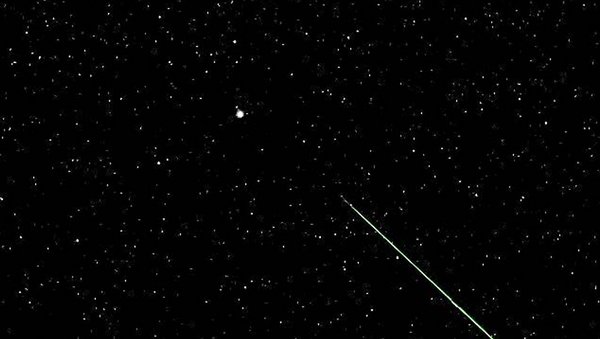
Review: The lidar beam from TROPOS-Polly pointed to Polaris - an unmistakable sign that the North Pole was not far away during the drift in winter 2019/20. Photo: Hannes Griesche, TROPOS
30. June 2020 (N81°47, E08°57)
First works on the ice and first operation of "BELUGA"
Hello everyone at home,
Another week has passed. I went on the ice for the first time helping to move ARM and NOAA instruments to Met City. There, we set up the Met City tower and mounted first instruments on it. The Met City tower was finally raised a couple of days later. After the work at Met City, I helped at Balloon Town to move the heavy winch in place. For that, we had to slide it on wood plates.The second time I went on the ice was to help to inflate the Beluga balloon during an extended morning slot. Next to Polarstern, we held the balloon down with multiple ropes while it was filled from a rack of balloon gas bottles on the working deck. Despite warm temperatures, holding the ropes above my head caused quite cold fingers quickly. Afterwards, we pulled the balloon gently with a skidoo to Balloon Town and put it in its parking position. Its first operation with payload was then a couple of days later. During this whole procedure, the UFA film crew accompanied us and I even tried to answer some of their questions in Swiss German as requested.We dismounted the ARM Parsivel from OCEANET to install it in Met City, which worked fine. Sadly, the repair of the sun photometer turned out to be a more complicated issue. It was not a lose screw, it was a ripped apart belt, which I tried to repair in an improvised way, first with glue and duct tape, then with sewing and duct tape. The outcome is unclear, but I am not optimistic at all as using these materials are quite challenging in the cold Arctic climate. The calibration of the microwave radiometers is still on the to-do-list. Furthermore, the reinstallation of a sodar next to Met City as a group effort of the Atmos team is planned for the coming week.I still do at least one shift of bridge watch per day and try to help others onboard if needed, for example, I helped out some of the Ice team with our laser safety glasses.
Best regards,
Julian
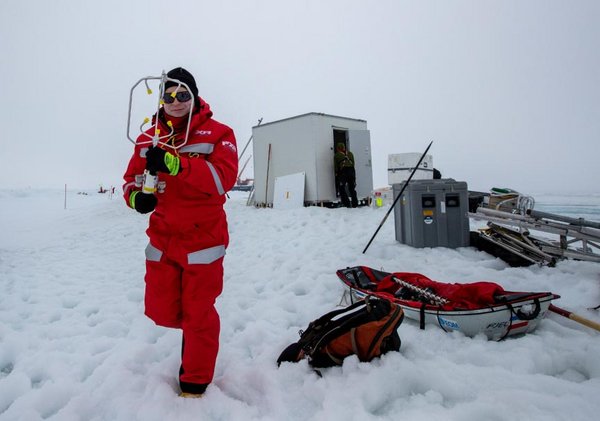
Julian Hofer during works at "Met City" on the ice. (Foto: Lianna Nixon, University of Colorado)
22 June 2020 (N81°57, E09°12)
My start in my new home
Hello everyone at home,
after 2.5 weeks of quarantine in Bremerhaven and 2.5 weeks onboard R/V Sonne, we have been onboard the R/V Polarstern for 2 weeks. Martin did a comprehensive hand-over to me. Since then, I am taking care of the OCEANET systems, which are mostly running well. I am also looking after the Doppler lidars from Trier/Leeds. ARM and NOAA people are helping me in setting up the new Parsivel Disdrometer on the bow crane, which is at the moment operating in parallel to the ARM Parsivel that is still installed on the OCEANET container. At the few clear days, I made some measurements with the handheld Microtops sun photometer. The weather technician here onboard also volunteered to do some Microtops measurements, for example, today he does hourly measurements.
Since a couple of days, we are back at the original MOSAiC ice floe, which is looking completely different now, having a lot of melt ponds and soft ice/snow. After a couple of reparking maneuvers, we finally arrived our final position. Yesterday, phase 1 started to reinstall the infrastructure on the ice. I have not gone on the ice yet, but I volunteered for sternwatch a couple of times. Watches are essential, as we have already encountered many polar bears and polar bear tracks. After this initial and intense set up phase, where individual science should be put second in priority, I will do a calibration of the microwave radiometers next and do work on the CIMEL sun photometer.
I am also getting used to the life here onboard. I think we have a good team, and especially within the ATMOS team, we are getting along very well. Volunteering is working fine, and everybody is helping each other.
Best regards,
Julian
https://follow.mosaic-expedition.org/blog/mosaic_22-6-20/?lang=en
17 June 2020 (N51°21, E12°26)
Welcome back, Martin!
On Monday, the two research vessels Sonne and Maria S. Merian arrived in Bremerhaven and with them the team from MOSAiC cruise section 4 - including our colleague Martin Radenz, who had been on tour since February and spent a total of 140 days at sea and in the ice.
His conclusion:
"In retrospect, Leg 3 was unexpectedly challenging, on the one hand due to the conditions on site with temperatures of -42°C at the end of the polar night until the beginning of the melting season at the end of May. Already the arrival and supply of the icebreaker Kapitan Dranitsyn required nautical skill and a lot of patience from all involved. Arriving at the MOSAiC floe, the ice conditions were exceptionally dynamic throughout the whole time and the drift was comparatively fast. To maintain the measurements despite constantly changing cracks and press ice ridges required a joint effort of the entire team - science and crew of Polarstern.
From the perspective of ground-based remote sensing of the atmosphere, the data set from Leg 3 offers a wide range of interesting observations: Marine aerosols despite dense pack ice, "Arctic Haze" in spring, warm air intrusion from the south and often mixed phase clouds at low altitudes. The second challenge was imposed on us by the Corona pandemic and the associated travel restrictions. The replacement originally planned for April was delayed until June and required Polarstern to leave the floe. The journey from the floe to Spitsbergen was also made more difficult by the compact ice situation, before the handover to Leg 4 in the Isfjord took place and we were able to start our journey home," Martin Radenz from TROPOS summarised the last 5 months.
Martin is the third of the TROPOS lidar group, which is responsible for ensuring that the OCEANET container on the foredeck measures around the clock during the one-year North Pole drift of Polarstern. Thanks to the excellent set-up work of our colleague Ronny Engelmann, the lidar measurements could start in autumn without any complications and go into the polar night. Hannes Griesche took care of the technology from Christmas 2019 and got it through the polar night with darkness around the clock and extreme cold. Martin Radenz took over the care in February and experienced spring in the Arctic with the return of the sun and rising temperatures. Julian Hofer has been taking care of the container since June. An exciting time of summer in a thawing Arctic awaits him. Finally, Dietrich Althausen will conclude the one-year Polarstern expedition on the last leg and bring the TROPOS remote sensing devices back home.
Many thanks to all for their efforts!!!
08 June 2020 (N78°14, E15°37)
Triple summit off Svalbard
The German research vessels Maria S. Merian, Sonne and Polarstern met off Spitsbergen in early June to exchange team and technology for the next leg of the MOSAiC expedition. Due to the corona pandemic, the exchange took place at sea - at a safe distance from the port of Longyearbyen.
The BMBF and AWI informed about the corona-related changes at a press conference with live transmission to Spitsbergen on 8 June:
https://www.bmbf.de/de/was-sie-zur-expedition-mosaic-wissen-muessen-9700.html
With a new team and fresh provisions, Polarstern is now heading north back into the ice. For Christian, Julian and the other participants of section 4 the expedition is finally getting off to a good start. The Merian and Sonne, on the other hand, are heading back to Germany, bringing our colleague Martin, among others, back home after almost half a year. Have a good journey!
https://follow.mosaic-expedition.org/blog/mosaic_8-6-20/?lang=en
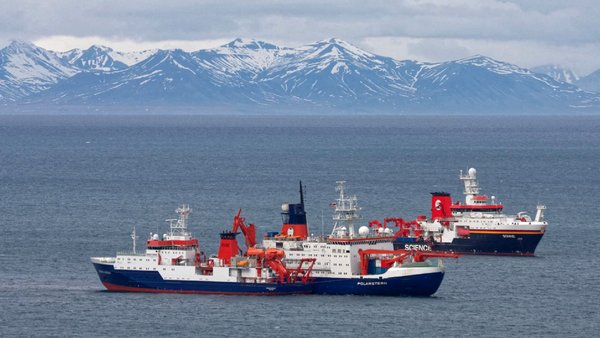
RV Maria S. Merian, Polarstern and Sonne during the change off Spitsbergen. Photo: Leonard Magerl
04 June 2020 (N78°03, E15°06)
Off the coast of Spitsbergen
After 17 weeks in the Arctic ice, Section 3 of the MOSAiC expedition is nearing its end. "We left as the 'short and easy' leg, but #seaice dynamics, weather and the corona pandemic provided a stream of unexpected challenges. What an unbelievable time.", writes our colleague Martin as a conclusion on Twitter. The Polarstern is now moored off the port of Longyearbyen (Svalbard/Spitsbergen) and thus back within the range of normal mobile radio...
In the coming days, the supplies will be replenished and the teams will change ships.
27 May 2020 (N80°55, E09°42)
ATMOS without pause
Despite having left the MOSAiC floe, quite a lot measurements– apart from the autonomous instruments left behind - continue on board Polarstern. One example are the nine containers of the ATMOS team on the bow and the monkeydeck. The instruments provide continuous data on the atmospheric the atmospheric state, trace gases, composition of aerosol particles and cloud properties. An extensive suite of instruments from various institutes is necessary to capture all relevant parameters. “For the scientists and technicians responsible for these observations normal working routine continues until the handover to Leg 4. In fact, the opportunity to observe a transect from the dense multi-year ice to open water provides valuable insight into the spatial variability of the atmosphere and of chemical and microphysical processes over the Arctic sea ice cover", reports our colleague Martin in the MOSAiC blog. During Leg 3 he was responsible for the lidar and various other measuring instruments of the OCEANET container of TROPOS.
https://follow.mosaic-expedition.org/blog/1499/?lang=en
27 May 2020 (N82°23, E08°20)
Waiting for Polarstern
The supply ships with the team for section 4 (incl. 2x TROPOS & 1x Leipzig University) have meanwhile arrived off Spitsbergen and are now waiting for Polarstern in a wind-protected fjord. The German research icebreaker makes its way through the ice. In many parts of the Arctic there is little ice in 2020 - but the current is driving the little ice southwards. The ice then dams up off Spitsbergen, and Polarstern has to pass through it.
The ATMOS team (including our colleague Martin) will of course use the transit to the open sea for further measurements: The lidar scans the atmosphere above Polarstern and four times a day weather balloons are launched from the helicopter deck together with DWD. The data sent down by the balloons not only help the on-board weather station but also flow into the worldwide weather forecasts.
https://follow.mosaic-expedition.org/blog/mosaic_27-5-20/?lang=en
19 May 2020 (N83°22, E09°01)
Quarantine, ice floe cleared and replacement started in Bremerhaven
The team for leg VI (incl. 2x TROPOS & 1x Uni Leipzig) has prepared for the expedition in Bremerhaven. Preparation meant here: 2 weeks quarantine and therefore isolated in the hotel room. Even food was only placed in front of the room door to minimize direct contacts & the risk of Covid-19 infection. https://follow.mosaic-expedition.org/blog/mosaic_13-5-20/?lang=en
Meanwhile the team of section 3 has cleared the MOSAiC floe and prepared it for the absence. After 7 months we have to say goodbye and hope that the floe is still intact when Polarstern returns in a few weeks after the team change. https://follow.mosaic-expedition.org/blog/mosaic_17-5-20-2/?lang=en
On 18 May, RV Sonne and RV Maria S. Merian took off from Bremerhaven with 56 researchers, 37 crew members and 14 tons of food. The change of personnel is to take place off Spitsbergen as these research vessels are not icebreakers. Therefore the RV Polarstern has to leave her position in the ice for about 3 weeks ... https://follow.mosaic-expedition.org/blog/mosaic_18-5-20/?lang=en
Videos:
https://twitter.com/MOSAiCArctic/status/1262352374716342272
www.zdf.de/nachrichten/heute-in-europa/crew-austausch-auf-der-polarstern-100.html
www.sat1regional.de/trotz-corona-neue-mosaic-versorgungsschiffe-starten-von-bremerhaven-aus-in-die-arktis/
11 May 2020 (N83°28, E13°05)
Aerosol research & MetCity on the ice floe
"Where do aerosols come from above sea ice?"
Markus Frey from the British Antarctic Survey and Julia Schmale from the Swiss Paul Scherrer Institute (PSI) report on this important factor for clouds and climate in the Arctic in the MOSAiC blog: https://follow.mosaic-expedition.org/blog/mosaic_11-5-20/?lang=de
Why is the ice floe around MetCity slowly emptying?
More about this also in the MOSAiC-Blog: https://follow.mosaic-expedition.org/blog/mosaic_10-05-20/?lang=de
08 May 2020 (N83°55, E16°40)
New pictures from the polar night
The ARD Tagesschau in the German 1st tv channel (Das Erste) shows new pictures from the Arctic expedition MOSAiC and reports about the upcoming team change:
http://tagesschau.de/multimedia/video/video-699017.html
07 May 2020 (N83°55, E16°40)
Arctic Clouds
Clouds are an important part of the Arctic climate system and are different from clouds at low latitudes. "Clouds consist of small water droplets, ice crystals or a mixture of both. At temperatures as low as -38°C, the liquid phase forms first. When, whether and how many ice crystals form depends on many variables such as temperature, humidity, turbulence and aerosol particles," explains Martin Radenz from TROPOS on the MOSAiC blog. And Chris Cox (University of Colorado/CIRES/NOAA-PSD) continues: "Clouds modify the atmospheric boundary layer and the surface energy balance. We are particularly interested in mixed-phase clouds, which contain both ice particles and water droplets ..."
https://follow.mosaic-expedition.org/blog/mosaic_07-05-20/?lang=en
26 April 2020 (N83°56, E15°31)
Old arctic air masses and new warm air
For MOSAiC, March and April were characterized by a steady northern air flow, which was responsible, among other things, for the rapid drift south. "From an atmospheric science perspective", says Julia Schmale, "this means that we have seen very old Arctic air masses. Old means that the air spent several weeks in the high Arctic and therefore the composition of trace gases and aerosol particles is very homogeneous and changes only slowly". The warm air intrusion in mid-April brought an abrupt change: air was flowing in over the North Atlantic. Where algae blooms are already happening this time of year. "... The clouds were also different with many liquid droplets in contrast to the ice crystals otherwise. This is a first glimpse into the exciting times for atmospheric chemistry and microbiology in the coming weeks", reports Julia Schmale from the Swiss Paul Scherrer Institute (PSI): https://follow.mosaic-expedition.org/blog/mosaic_25-4-20/?lang=en
(Her group from the Laboratory of Atmospheric Chemistry (LAC) also reports in a blog from the MOSAiC expedition: https://www.psi.ch/en/lac/mosaic-blog)
More blog entries from Team Atmos: follow.mosaic-expedition.org/blog/mosaic_4-4-20/ & follow.mosaic-expedition.org/blog/mosaic_9-4-20/ & follow.mosaic-expedition.org/blog/mosaic_11-4-20/
A warm air burst reached MOSAiC on 19.04.2020 in the afternoon (15:00 UTC) at 84.6°N and caused the thermometer to rise briefly to freezing point (-0.1°C = 32F) - see also data from the DWD on-board weather station on Polarstern: https://www.awi.de/fileadmin/user_upload/MET/PolarsternCoursePlot/psobsedat.html & https://www.dwd.de/DE/fachnutzer/schifffahrt/maritimberatung/mosaic/polarstern/polarstern_node.html
25 April 2020 (N84°00, E15°37)
Polar bear break over
On Wednesday, after a long break, there was another four-legged visit: "In the early hours of the morning, a polar bear was sighted in our observatory for the first time since the beginning of January. The well-fed polar bear took an interested tour between the setups on the floe...", the team reported in the MOSAiC blog: https://follow.mosaic-expedition.org/blog/mosaic_24-4-20/?lang=en
24 April 2020 (N53°32', E08°34')
Alternative plan for Polarstern supply in place
The MOSAiC expedition will continue despite the Corona pandemic thanks to the support of the German research vessels Merian and Sonne. The new MOSAiC team starts in May from Bremerhaven.
The MOSAiC expedition can continue despite the current challenges. After the international border closures caused by the Corona Pandemic a team exchange had to be postponed. Thanks to new alternative plans supported by the German Federal Ministry of Education and Research (BMBF), the German Research Foundation (DFG) and the operators of the German research fleet and the great commitment of the current expedition team on board, MOSAiC can continue. The interim balance of the project shows: The valuable data of the coming months are indispensable for science.
For more information, see the AWI press release at https://www.awi.de/en/about-us/service/press/press-release/alternative-resupply-plan-for-polarstern-now-in-place.html
And our colleague Martin Radenz adds: "We are doing well so far, no reason to complain :)".
16 April 2020 (N53°32', E08°34')
World Press Photo Award for photo by MOSAiC
Esther Horvath wins one of the highest awards for photographers worldwide with a motif from the MOSAiC expedition
A female polar bear and her cub are curiously exploring the MOSAiC research camp under the spotlight of Polarstern - with this motif, Esther Horvath, photographer and picture editor at the Alfred Wegener Institute, the Helmholtz Centre for Polar and Marine Research (AWI), won the World Press Photo Award in the category "Environment" as a single image. This was announced by the World Press Photo Foundation on the evening of April 16th.
For more information, see the AWI press release: https://www.awi.de/ueber-uns/service/presse-detailansicht/presse/world-press-photo-award-fuer-awi-fotografin.html
This autumn's photo is not the first photo of a mother polar bear with her cub to be picked up by the media. Already in PS106 2017, a snapshot by Hauke Flores of the AWI made the headlines. See https://www.tropos.de/fileadmin/user_upload/Aktuelles/Messkampagnen/Bilder_2017/Messkampagnen_2017/PS106.1_PASCAL/PS106.1_PASCAL_Polarstern-Blog/PS106_Blog_4_Bild_4_Hauke_Flores_800p.jpg
>
https://www.spiegel.de/wissenschaft/natur/eisbaer-in-der-arktis-klaut-fahnenstange-a-1151505.html
&
https://www.tropos.de/aktuelles/messkampagnen/blogs-und-berichte/polarsternfahrt-ps106-2017
Easter Monday, 13 April 2020 (N84°17, E14°55)
Easter greetings from the ice!
"We send hearty Easter greetings to our loved ones back home and all friends of MOSAiC! ... on sunday evening there was a barbecue together. We are aware that this is a privilege in these extraordinary times", the team writes in the blog. https://follow.mosaic-expedition.org/blog/mosaic_13-4-20/?lang=en
02 April 2020 (N84°58, E15°06)
Bye, bye, North Pole!
On its drift, the ice floe of the MOSAiC expedition has passed the 85th latitude towards the south and thus left the central Arctic. AWI sea ice physicist Stefanie Arndt captured this moment in the photo with a self-made "place-name sign".
01 April 2020 (N85°08, E15°27)
Polar day at MOSAiC
"Just five weeks ago, it was pitch black here. At the beginning of March, beautiful twilight colours took over the sky, until finally on 12 March the sun rose above the horizon for the first time again. And now, less than 2.5 weeks later, it no longer sets. Since yesterday we have been experiencing Polar Day", the team writes in the MOSAiC blog: https://follow.mosaic-expedition.org/blog/mosaic_1-4-20/?lang=en
01 April 2020 (N53°03', E08°47')
Back to the light and home!
No April fool's joke: On April 1st they are finally back in Germany - the participants of MOSAiC trip section 2.
Arrived! For the researchers, among them Hannes Griesche, a scientist from TROPOS in Leipzig, the journey took longer than originally planned. They spent a total of four months (including Christmas) in the Arctic - including the time when the temperatures during the polar night fall below -30°C in complete darkness...
The exchange had been delayed because the Corona pandemic had made it impossible to fly over Svalbard and because of unusually thick ice this winter. Strong winds stopped the Russian supply icebreaker Kapitan Dranitsyn at the beginning. The breaking of the strong sea ice took longer than planned and consumed so much fuel that a four-day refuelling stopover was necessary on the return journey. A second icebreaker, the Russian Admiral Makarov, came to the aid of the ship in mid-March. On 31 March, the Dranitsyn finally reached Tromsø in northern Norway. From there, a charter plane took her to Bremen. More about this in the MOSAiC blog: https://follow.mosaic-expedition.org/blog/mosaic_31-3-20/?lang=en & https://follow.mosaic-expedition.org/blog/mosaic_16-03-20/?lang=en
28 March 2020 (N83°37, E13°19)
First Raman lidar measurements in the central Arctic in spring
“Hi everyone,
we have arrived at the MOSAiC floe almost a month ago. Since then time went by like a breeze. The sun has returned and illuminates the landscape around us in magnificent colors. Currently the sun sets for a couple of hours during night, but remains only slightly below the horizon to provide twilight conditions 24 hours long. In a few days, it won't set until fall.
Doing science in the central arctic remains a challenge. Forces of wind and tides keep the ice moving and dynamic. For the whole time 'our' flow was located within a particularly active shear zone, meaning the frequent formation of cracks, leads and ridges. This also affects the installations and logistics on the ice and we frequently have to relocate and repower instruments to ensure continuous, high quality measurements. As of today, the ship's leadership considers relocating the ship to a less dynamic part of the floe.
The observations done by OCEANET are very interesting at the moment. Lofted aerosol layers of arctic haze and sea spray are present almost the whole time. These are the first Raman lidar observations in the central arctic in springtime. Additionally, frequent layered mixed phase clouds satisfy all the desires of more cloud-process related researchers.
The corona-pandemic affects us here as well. Because of the travel restrictions, the rotation between Leg 3 and 4 is postponed until early June. Hence, the stay of the Leg 3 science party will be most likely extended by 2 months. Apart from concerns about the situation of loved ones at home, spirits are still high on board and the science program keeps us busy.
Many regards, Martin” - writes our lidar colleague Martin Radenz from the ice floe.
16 March 2020 (N78°15', E15°29')
MOSAiC aerial survey campaigns temporarily suspended. Polarstern crew continues to be unaffected by the corona pandemic
Due to drastic travel restrictions and due to the highly dynamic development of the corona pandemic, on Friday 13 March the MOSAiC project management decided to temporarily suspend the aerial survey campaigns planned for this spring and based in the Svalbard archipelago, which is under Norwegian administration. There are currently three icebreakers underway in the Central Arctic for the MOSAiC expedition.
For more information see the press release of the AWI > https://www.awi.de/en/about-us/service/press/press-release/mosaic-aerial-survey-campaigns-for-the-atmosphere-and-sea-ice-temporarily-suspended.html and in German at the Leipzig University > https://www.uni-leipzig.de/newsdetail/artikel/vorerst-keine-flugkampagnen-zur-vermessung-von-atmosphaere-und-meereis-2020-03-16/
14 March 2020 (N84°48', E42°35')
Icebreaker help on the way home
"Captain Dranitsyn left the MOSAiC ice floe with the team of cruise port 2 on March 4 and met Admiral Makarov on Saturday, March 14. This further icebreaker from Russia had left to provide fuel for the captain Dranitsyn after her long voyage through the Arctic ice ...", the MOSAiC team writes in the blog > https://follow.mosaic-expedition.org/blog/mosaic_16-03-20/?lang=en
We wish everyone a good, fast and safe journey home!
12 March 2020 (N87°27', E20°20')
The sun is back!
Goodbye polar night! Since 11:09 AM the sun is back on the ice floe of MOSAiC. It is still hiding on the horizon in the snow drift of a low pressure system, but the dark time is over for the MOSAIC expedition in the Arctic ...
https://follow.mosaic-expedition.org/blog/mosaic_12-03-20/?lang=en
03 March 2020 (N78°15', E15°29')
Leipzig Meteorologists to Join Survey Team With Research Aircraft
The time has come for a change of shifts on the MOSAiC expedition, a project for which the German icebreaker Polarstern is spending 14 months frozen in sea ice. The third phase of the expedition will also include scientific missions with the research aircraft Polar 5 and Polar 6, which will be overseen by meteorologist Professor Manfred Wendisch from Leipzig University.
Read more in the press release of the Leipzig University: https://www.uni-leipzig.de/en/newsdetail/artikel/leipzig-meteorologists-to-join-survey-team-with-research-aircraft-2020-03-03/
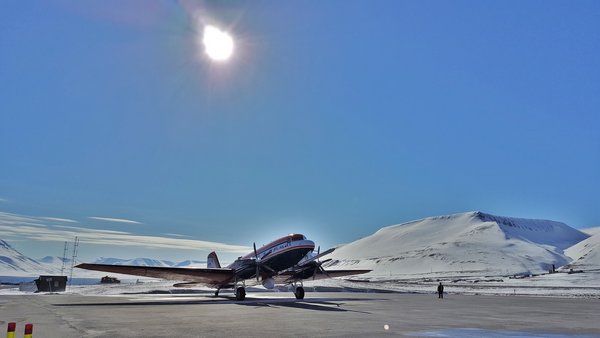
The Alfred Wegener Institute’s Polar 5 research aircraft on Svalbard. Photo: Tobias Donth, Leipzig University
01 March 2020 (N88°16', E31°45')
Further north than any other ship
Hello,
slowly my time here on Polarstern and on the MOSAiC floe is coming to an end. Since Friday afternoon the Dranitsyn is located in some distance next to Polarstern and yesterday Martin was here for the first time. Today we want to calibrate the HATPRO and possibly do a telecover test. Last week I changed the flashbulbs on our lidar "Arielle" after 160 million shots. That worked out well. And since a few days now it has finally cloudless high pressure conditions again.
The rest of the instruments continue to work well. I tried the Cimel-photometer again and tried to adjust the switches, which should regulate the engine revolutions, better. Unfortunately this is a very tedious story ... I think we will keep it to measure now this moon phase (since two days you can see the moon again here) as it is and then Martin unfortunately has to deal with it. He has a few new switches with him, I don't know if it would be worthwhile to replace them.
... In a few days we will go about 110 nautical miles away from the North Pole on a ship that cannot reach the next port under its own power. Of course I assume that with the Makarov, a Russian icebreaker chartered to meet us and provide us with fuel, everything will go well and we will arrive in Tromsø relaxed at some point. But how long we need for the way back and when we will be back home is still unclear. Our cruise leader is more relaxed: he asked the captain of the Dranitsyn if we could make a detour over the North Pole on our way back :-).
The next few days are scheduled for cargo operations to reload the cargo. They may take some time because of the extremely cold temperature (currently -38°C) ... then we'll head for the mainland (it's easy to forget when you're walking on ice, but we're still on an ocean).
By the way, we also received an award from the Scott Polar Institute: As far north at this time of year as we are (24.02.: 88°36'N) there was no other ship (officially at least :-) ).
Many greetings!
Hannes
01 March 2020 (N88°16', E31°45')
Light!
"Together with the new team, the twilight has arrived. For two weeks now there has been so-called "nautical twilight" and since today's Sunday we have been experiencing "civic twilight", during which the sun is only six degrees below the horizon. The definition of the latter is that you can read outside, and we can see the surface of snow and ice ...", Folke Mehrtens writes in the MOSAiC blog. https://follow.mosaic-expedition.org/blog/mosaic_01-03-20/?lang=en
28 February 2020 (N88°21', E34°13')
'They're arrived!'- Kapitan Dranitsyn reaches Polarstern
"They are here! We have had visual contact for two days, and now the time has come: The supply icebreaker Kapitan Dranitsyn arrived today in the immediate vicinity of Polarstern after a delay due to a difficult sea ice situation. The exchange of the two teams of cruise sections 2 and 3 is thus imminent. The task now is to replace a total of 83 scientists and crew members...", writes the MOSAiC team from the ice floe in the blog: https://follow.mosaic-expedition.org/blog/mosaic_28-02-20/?lang=en
And on board the Dranitsyn, Stefanie Arndt, sea ice physicist at AWI, writes on Twitter: “We did it! It is incredible but we finally arrived at #RVPolarstern @MOSAiCArctic - only 100 nm away from the North Pole - in the middle of #Arctic winter. At 14:17 ships time, we reached our final parking position - with an euphoric applause on the bridge #KapitanDranitsyn.” > https://twitter.com/arndt_st/status/1233368544819269632
We keep our fingers crossed for all of them for the exhausting days of the move! And of course especially our lidar colleagues Hannes (leg2, still on the Polarstern) & Martin (leg3, still on the Kapitan Dranitsyn)!
20 February 2020 (N88°35', E55°55')
MOSAiC Mondays – Weekly Updates from the Arctic (The Atmosphere: Part 1+2)
The MOSAiC expedition has not only set itself scientifically ambitious goals, it also wants to contribute to the younger generations learning more about the Arctic and the serious climate change there. For this purpose there is the Education Module. The Education Team takes care to prepare interesting and easily understandable information so that teachers can use it in their lessons. Colleagues from the Cooperative Institute for Research in Environmental Sciences (CIRES) in Boulder (Colorado, USA) report every week in English in their "MOSAiC Mondays - Weekly Updates from the Arctic":
https://mosaic.colorado.edu/education/mosaic-mondays
The issues of 24 February and 2 March 2020 are dedicated to the atmosphere and thus also to the TROPOS research area, the troposphere:
“MOSAiC Monday - February 24, 2020
This week: The atmosphere is an important component of Earth's climate system and a key science focus area of the MOSAiC expedition. Learn more about this thin veneer of gases and other things that is crucial to our survival. ”
https://mosaic.colorado.edu/education/mosaic-mondays/mosaic-monday-february-24-2020
“MOSAiC Monday - March 2, 2020
This week: The atmosphere, part 2 - What is air pressure, and what does it have to do with weather? Also, MOSAiC team members answer your questions about wifi on the ship and why a buoy is called a buoy.”
https://mosaic.colorado.edu/education/mosaic-mondays/mosaic-monday-march-2-2020
A clear recommendation for all who understand some English! So from about grade 5...
20 February 2020 (N51°21', E12°22')
POLARZEIT: EXPEDITION EXTREM - Conversation & Performance in the Museum of Natural History (in German)
The Leipzig researcher Ronny Engelmann reported on the largest North Pole expedition to date.
After the audience had experienced a live transmission to the research vessel "Polarstern" in December, the Leipzig researcher, who was part of the largest expedition to the North Pole so far, was now a guest on 20th February. Dr. Ronny Engelmann from the Leipzig Leibniz Institute for Tropospheric Research gave a vivid account of the research, polar bears and the extreme conditions of the mission in a conversation with museum director Dr. Ronny Maik Leder. The audience participated in the discussion with many questions.
http://www.schaubuehne.com/programm/polarzeit-expedition-extrem/
17 February 2020 (N88°21', E78°40')
Ice crystals - the art of the tiny
"We are obviously surrounded by ice and snow, since the Polarstern is frozen in ice. But did you know that ice crystals are also present in the air? They have different shapes depending on the temperature: massive plates or prisms, columns, star-shaped plates, needles or dendrites. Their size and shape also depend on the humidity of the air. In order to be able to examine these tiny crystals, they must be preserved in a plastic material after collection in order to produce an imprint that can then be photographed under a microscope, because otherwise they would melt away. A sewing needle is shown for size comparison. We are interested in its shape, for example in order to be able to better interpret our active remote sensing measurements of the atmosphere, because the different ice crystals influence the scattering of light and radiation differently," Folke Mertens reports in the MOSAiC blog. And our colleague Hannes Griesche adds: "I took the photos of the ice crystals with the IcePIC (Ice Particle Imaging Camera) from CIRES (Cooperative Institute for Research In Environmental Sciences in Boulder, CO, USA). This is a microscope on which a camera is mounted directly." https://follow.mosaic-expedition.org/blog/mosaic_17-2-20/?lang=en
14 February 2020 (N88°2', E80°7')
Leg 2 draws to a close
„Tradionally every expedition has a goup photo of all scientific participiants. We decided to have ours in front of our frozen home Polarstern: She is our shelter during the frosty polar night and we want to thank the crew for caring excellently fort he vessel and the MOSAiC familiy!“ writes the team in their blog: https://follow.mosaic-expedition.org/blog/mosaic_14-02-20/?lang=en
12 February 2020 (N87°54', E86°56')
A glimmer of light on the horizon!
"Yesterday there was a real change in lighting conditions. We have now so-called nautical twilight. The sun rises between 6° and 12° below the horizon ... . Accordingly, a lot of people came to the bridge yesterday to enjoy the colourful sky. We are very much looking forward to seeing the sun itself, which we did not see when we left Tromsø at the end of November for our MOSAiC adventure...", the team writes: https://follow.mosaic-expedition.org/blog/mosaic_12-2-20/?lang=en
02 February 2020 (N48°45', E08°14')
MOSAiC in television, radio and print (in German)
02 February
The ARD exclusively shows video recordings of the 1st MOSAiC leg at "W wie Wissen" in Das Erste (the first German Television Channel): https://www.daserste.de/information/wissen-kultur/w-wie-wissen/arktis-156.html & https://www.daserste.de/information/wissen-kultur/w-wie-wissen/videos/arktis-video-102.html
12 February
Photographer Esther Horvath talks on NDR television about how she worked with her camera in the cold & dark and what drives her at work: https://www.ardmediathek.de/ndr/player/Y3JpZDovL25kci5kZS9mMGExMjI2Ni1kMGE0LTRjODItYjU2NS0xMGFjYzZjNDNlMDQ/fotografin-begleitet-polarstern-expedition
13 February
The Polarstern ice floe reaches 88 degrees latitude. Karsten Schwanke reports on this expedition for ARD-alpha: https://www.br.de/mediathek/sendung/expedition-am-nordpol-av:5dd276f4ebea9c001ad8f003
13 February
"The ice isn't eternal" - Tilmann Bünz, ARD correspondent in Stockholm, reports on MOSAiC for the Tagesthemen in Das Erste (in the first German Television Channel): https://www.tagesschau.de/ausland/polarstern-arktis-101.html
14 February
"150 days in the polar night" - expedition leader Markus Rex from AWI talks for one hour about MOSAiC at NDR-Kultur: https://www.ndr.de/ndrkultur/Markus-Rex-war-150-Tage-in-der-Polarnacht,audio636202.html
15 February
"Trapped in ice: Aboard the Polarstern. Twelve months of drifting ice floes. An exclusive report from the largest Arctic expedition of all times" - The GEO-Magazine dedicates the cover story of its March issue to MOSAiC: https://www.geo.de/magazine/geo-magazin/39095-geo-nr-03-2020-gefangen-im-eis
15. February
„Diese Frau macht die Flieger fit für die größte Arktis-Expedition aller Zeiten“ - der Stern berichtet übe die „Polar 5“ & „Polar 6“, die im Zentrum der Flugzeugkampagne „MOSAiC Airborne 2020“ stehen, mit denen sich die Universität Leipzig an MOSAiC beteiligt: https://www.stern.de/reise/follow-me/arktis-expedition--diese-frau-macht-die-flieger-fit-fuers-ewige-eis-9125612.html
17. January:
Forscher berichtet von AWI-Expedition im ewigen Eis bei ‚buten un binnen‘ von Radio Bremen: https://www.butenunbinnen.de/videos/mosaic-expedition-polar-forschung-100.html
19. February
Arktis-Expedition der Polarstern. ARD-Morgenmagazin im Ersten: https://www.ardmediathek.de/daserste/player/Y3JpZDovL2Rhc2Vyc3RlLmRlL21vcmdlbm1hZ2F6aW4vYmExZGMzYzQtODhlMy00MWM5LWFiNDAtNTU5ODg5NTQyMmUw/arktis-expedition-der-polarstern & Interview mit Expeditionsleiter Prof. Markus Rex https://www.daserste.de/information/politik-weltgeschehen/morgenmagazin/videos/markus-rex-polarforscher-100.html
31 January 2020 (N87°26, E96°28)
Arctic heat wave: +25K within a few hours
Researchers expect that climate change will lead to more frequent and stronger weather conditions in the future, which will transport heat from the south to the central Arctic. What will then happen there locally? How does this change the clouds and aerosols in the atmosphere? How do these heat waves accelerate the melting of sea ice? These are many questions for atmospheric research. Accordingly, the MOSAiC team Atmos was curious to see whether they would be able to experience and measure such events on site.
Then, at the end of January, what the researchers had been waiting for happened: a heat wave with drastic temperature fluctuations in an extremely short time - in the middle of the polar winter: "In the early morning of January 28th, we experienced the coldest temperature ever recorded, -35.1°C. Then, within the following 24 hours, the values rose to our 'normal', approximately -25°C. But instead of staying like this, it became warmer and warmer up to our maximum temperature on MOSAiC section 2: Quasi tropical -10.8°C on the morning of January 30th. But then the thermometer immediately dropped back to -35°C within only 17 hours. Imagine a temperature drop from 25°C to 0°C in this time span! The warming was accompanied by strong winds, partly clouds and snowfall. We assume that a low-pressure system passing above us has brought warm air from Svalbard to us and that the clouds with their reflection effect have additionally contributed to the warming. Team Atmo is already analysing the data from the lidar and radar measurements of the clouds in order to be able to say more about their composition", writes Folke Mehrtens in the MOSAiC blog.
https://follow.mosaic-expedition.org/blog/mosaic_31-01-20/?lang=en
The current weather with air and water temperature, wind speed as well as air pressure is available hourly from the DWD weather station on Polarstern:
https://www.dwd.de/DE/fachnutzer/schifffahrt/maritimberatung/mosaic/polarstern/polarstern_node.html
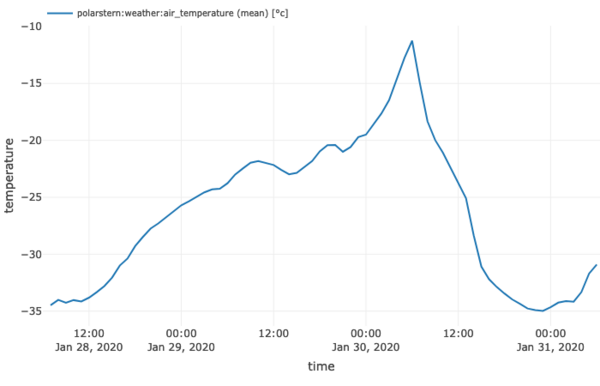
The graph shows how the air temperatures on Polarstern rose very rapidly from noon on 28. January until the morning of 31. January and then decreased again very quickly. From the morning of 31 January until the evening, the "mercury" fell from -10.8°C to -35°C. That is about -25K in just 18 hours! Graphic: MOSAiC Expedition
26 January 2020 (N69°39′, E18°57′)
A nice bath in the harbour
Hi all,
I have arrived at Tromsø well (even with my luggage on time).
Last two days were occupied with briefing(s), clothing and safety instructions.
Weather is quite nice (-15C, bit of wind) and we had a nice bath in the harbor. We were promised immersion suits, but turned out to be flotation suits, so we got fully wet.
However, everybody managed to get back on the simulated (ice) flow and now we are ready to leave.
Hannes has guessed correctly, the Russians icebraker had to do face the strong winds and waves abow (7BFT+ and ~5-6m) and took a slight detour.
New plan is, that we will board tomorrow and leave on Tuesday, weather and customs permitting.
Best,
Martin
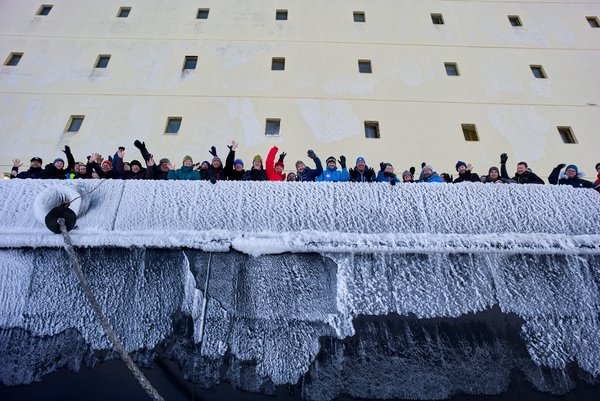
(28 Jan 20) The participant of the 3rd leg of MOSAiC has had some intensive days with last training courses and various briefings in Tromsø. Now they are waiting for the departure of the Kapitan Dranitsyn. The Russian icebreaker will also bring the next MOSAiC team to Polarstern, thus enabling the exchange of researchers, logistics and ship crew. Have a good trip!
Photo: Michael Gutsche, MOSAiC (https://follow.mosaic-expedition.org/blog/mosaic_28-01-20/?lang=en)
26 January 2020 (N87°25; E94°17)
Camping in the Artic winter? On the ice? Why not?!
Hello Leipzig!
This time in English, so the non-German speaking receiver can also enjoy the news from...well I was about to write the north pole. But that's no quite right. But almost! (155nm...no 155NM to go!).
I'm sorry for the long silence from my side. But don't be afraid, I'm not frozen in the arctic ice. Though, we went on a camping trip last night!
But let's start earlier. We had a quite exiting week the past 7 days. Exactly one week ago we noticed that there was a polarbear visit during the night. Nobody saw him, but there's an automatic camera at the remote sensing site on the ice. And during a regular check of these pictures they noticed that one instrument had a different position as the day before. So they checked all pictures until they finally saw the bear. But this bear is quite sience friendly! He only touched the instrument that was broken anyway. Maybe he thought a soft hit would help. Also he checked the remote sensing site out.
Here's what they wrote about his visit: "One great photo shows the bear tracks approaching the ARM "Swing Set" which supports radiometers that look down at the surface and measure up welling shortwave and long wave radiation and surface temperature. Operators during their daily inspections are instructed to keep the surface under the swing set as undisturbed as possible. Apparently the bear go the message. This great photo by Eric Brossier taken when Team LOGISTICS was searching the CO on the morning after show that the bear approached the swing set and then stopped. He then went around to the other side, stood up on his back legs to examine the radiometers, and backed away without making a single mark under the sensors. While it might have been interesting to look at the IR signature from a bear paw print, it appears that this this bear might be qualified for a job with ARM as his examination of the radiation sensors showed perfect procedure."
Next Dean (another Atmos Team member, whom I was bear guarding) and me experienced some polar light a few days ago. They were quite weak, but we were anyway quite excited to see some up here (though I haven't thought about, that the magnetic north pole is actually on the other side of the geographic north pole from our point of view.
The adventures continued on Friday, when a lead was discovered close to the ship. This opportunity was used to start an event (which apparently should happen twice per leg or so) and lots of people went out. Since I wasn't involved at all in this matter here what their report: "This was the long-awaited “event”: the chance to measure energy and gas fluxes between the water and air, through the newly formed and older ice. It also allowed to study the initial population of the newly forming ice by ice-inhabiting biota. After a short meeting after lunch, we mobilized very quickly to go out to measure and sample the open water, ice and snow, and air. This was strongly supported by the logistics team providing transportation and bear guarding. Additionally, we carried out a special high-resolution survey of the lead with the helicopter borne laser scanner. This was a great interdisciplinary effort to unravel the secrets of the Central Arctic in winter."
And then last night we made the camping trip. 20 people (including me), most of them scientist but also some of the Polarstern crew, went out to spent one night in tents, roughly one kilometre from the ship. This was a very nice experience. My favourite part was actually the bear watch I did from 1-2am. Being out there, alone and experience the arctic night almost undisturbed (there was still light from the ship but finally no noise anymore!). But it was also quite cold! We had really good sleeping bags but the problem were the mattresses. Some took two but I had only one and that unfortunately was not enough (so if I wrote some funny stuff in here, its due to the fact that I almost didn't sleep last night ;)). But maybe we go again next weekend, then I will take two mattresses! And the coffee in the morning was delicious (with fresh grinded coffee bones!).
Oceanetwise everything runs smoothly apart from the Cimel. But I finally managed to do the repair the guys from Lille told me to do. Unfortunately getting the robot down and put it up again and again and again wasn't good for the cables and one broke. Luckily we have some handy electricians on board who helped me to solder the wires! …
So far the report from MOSAiC, I think I have to go to bed now. …
Cheers,
Hannes
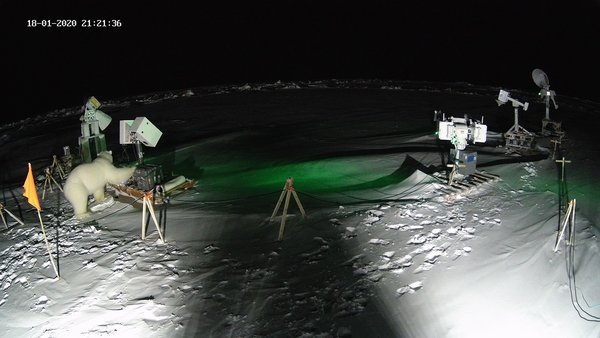
A polar bear visited the Remote Sensing Station on the ice at night and inspected the instruments. This was shown by the surveillance camera footage the next day. Fortunately, the polar bear approached very carefully and only tore off one cover without breaking any other installations. Photo: Marcus Huntemann, AWI ( https://follow.mosaic-expedition.org/blog/mosaic_20-1-20/?lang=en )
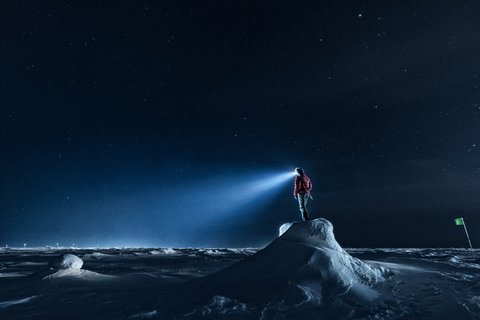
As soon as research teams are working on the ice, a bear guard is on the bridge. Supported by a scientist, also with binoculars and looking out with an infrared camera, the logistics team members have an eye on the surroundings. They are in radio contact with all groups working on the MOSAiC floe. Photo: Lukas Piotrowski, MOSAiC
22 January 2020 (N87°26, E93°52)
Northern lights at MOSAiC
'You won't see any northern lights on the MOSAiC expedition, you are too far north for that', they said before. Normally this phenomenon occurs mainly in a narrow band around the magnetic poles. Aurora Borealis occurs when electrically charged particles of the solar wind meet oxygen and nitrogen atoms in the upper layers of the Earth's atmosphere and ionize them. This produces the striking green light.
Our colleague Hannes Grische and Dean Howard from the University of Colorado Boulder have now taken a special snapshot. When they were on the ice floe to measure trace gases, they noticed faint structures in the dark sky that moved at a speed untypical of clouds. "Fortunately we had a camera and tripod with us and were able to take some long time exposure shots", reports Hannes. The photos clearly show that there are northern lights at 87° 28' North!
The almost vertical line in the upper part of the picture is the tracer of a polar orbiting satellite. These can be seen particularly clearly during the polar night, as they are illuminated by the sun while the ground is dark. By the way, for the photo they had to stand still for 25 seconds - at -27°C ...
https://follow.mosaic-expedition.org/blog/mosaic_23-1-20/?lang=en
08 January 2020 (N51°21'9", E12°26'5")
Lidar data now online
The lidar data of the TROPOS PollyArielle in the OCEANET container from the 1st leg of MOSAiC are now online in the TROPOS database: http://polly.tropos.de/?p=lidarzeit&Ort=35
All stations of the worldwide lidar network PollyNet are available under: http://polly.tropos.de/ as well as http://picasso.tropos.de/
More about PollyNet, which is part of ACTRIS, at: https://www.tropos.de/en/research/projects-infrastructures-technology/coordinated-observations-and-networks/pollynet
05 January 2020 (N87°4; E115°19)
Minus temperatures and darkness
...can't shock Hannes Griesche. The "Morgenpost am Sonntag" reports about the MOSAiC expedition (in German).
01 January 2020 (N86°44; E117°36)
New Year & northernmost New Year's Eve party in the world
Happy New Year!
We have almost felt -50°C here on the ground today (with actual -31 and with about 10m/s wind). In the atmosphere above us it is even colder: -78°C is measured by the radiosonde at 18km altitude.
The next station point is the North Pole and therefore the distance to it is always displayed. Currently it says: 197.45 NM - that is nautical miles. That's 365km - compared to the 4361km only a stone's throw ;-)
Our time is Moscow time by the way. So we were 2 hours ahead of Germany in 2020 and we have indeed a bright starry sky again.
Many greetings!
Hannes
PS. By the way, New Year on RV Polarstern sounds like this: https://www.awi.de/fileadmin/user_upload/AWI/Expedition/Schiffe/Downloads/Polarstern-Horn2.mp3
29 December 2019 (N86°38; E115°52)
Still 202.22 NM to the North Pole
Hello home,
here's a little inter-year-old e-mail. But not much has happened here in the last few days. We had two visits from an arctic fox (enclosed a photo). But even though they were always around polar bears, we have not seen them yet.
Our lidar "Arielle" got a small Christmas cleaning from me on 23.12. And right in the evening the computer restarted itself. But since then everything is running as usual again. Only interesting traps are left out. In the last days we had more and more low clouds again, so that there are rarely signals from above 2km. And if there are, I keep my eyes open for Polar Stratospheric Clouds (PSCs). But so far I have seen nothing like that in the data. The rest of the instruments are measuring diligently and the Cimel photometer is eagerly waiting for the moon to rise again.
Christmas Eve we had a nice Christmas party (which we defined as the northernmost in the world), with speeches from the captain and cruise director, a visit from Santa Claus and gnome presents for everyone.
On Christmas Day we had excursions on foot or, whoever had some, by ski (I was able to borrow a pair and was in the ski group). On New Year's Eve the next official celebration was already on the agenda, with a greeting of the New Year on the bridge.
I wish everyone a happy new year!
Many greetings from the ice,
Hannes
24 Dezember 2019 (N86°38; E113°46)
Christmas eve
The MOSAiC expedition team is enjoying a cheerful Christmas eve aboard Polarstern. Santa did pay us a visit!
21 Dezember 2019 (N86°41;E112°24)
Winter solstice
From now on the days will be longer!
Hello to Leipzig,
here comes an update from the floe. In the container I was able to look in regularly and my predecessor Ronny arranged everything very nicely for me. I only had to restart a software to copy all the data to the central data center here, but everything else runs fine and measures.
Yesterday evening the deep clouds finally disappeared and our Lidar Polly-Arielle could measure aerosol layers again. And there were two of them the whole evening below 2km and one at 5km. And I'm not sure, but above 11km could be the stratospheric aerosol that we have seen here so often lately. The tropopause is now again at 11km altitude.
Yesterday we had the shortest of our non existing days and celebrated it properly. We had mulled wine with it and it is recommended to enjoy it in thermos cups. Otherwise it is said to be frozen faster than drunk. .-)
Merry Christmas holidays to all!
Hannes Griesche
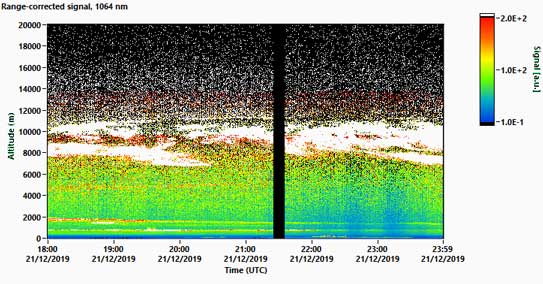
"The many high clouds up to 11 km indicate (once again) that the Arctic is not a closed system. Again and again air masses from rather middle latitudes cross the pole. The stable air masses (and embedded aerosol layers) further down (below 5-6 km) are probably more typical for winter Arctic conditions", Albert Ansmann (head of the TROPOS Ground Based Remote Sensing working group) interprets the measurement of 21.12.2019. Graph: Hannes Griesche, TROPOS
19 December 2019 (N86°40; E112°52)
Change Leg 1 to 2 finished
The Russian supply icebreaker Kapitan Dranitsyn left the MOSAiC ice floe on December 18 2019 at 14:30 ship time (12:30 CET). Thereby the supply and exchange between leg 1 and leg 2 is completed. Photo: Alfred-Wegener-Institut / Folke Mehrtens (CC-BY 4.0)
18 December 2019 (Leipzig/Dresden)
Shift change at the North Pole in the media
The change between cruise section 1 and 2 at MOSAiC is reported by others in German:
+ Sächsische Zeitung am 19.12.19: "Schichtwechsel am Nordpol" > https://www.saechsische.de/plus/schichtwechsel-am-nordpol-arktis-expedition-mosaic-saechsische-wissenschaftler-tropos-leipzig-5152729.html
+ MDR-Sachsenspiegel am 17.12.19: "Wie Leipziger Forscher in der Arktis am Klima forschen" > https://www.mdr.de/video/mdr-videos/a/video-366150.html
+ MDR-Radio-Sachsen am 17.12.19: "Schichtwechsel auf der Polarstern - Leipziger Forscher im Interview" > https://www.mdr.de/sachsen/leipzig/leipziger-forscher-polarstern-expedition-100.html
17 Dezember 2019 (Leipzig)
Performance "POLARZEIT: Expedition extrem"
The performance at the Natural History Museum Leipzig was accompanied by a telephone conversation with researcher Ronny Engelmann (TROPOS) from Leipzig who, as part of the international MOSAiC expedition, is currently drifting through the Arctic on an ice floe with the research icebreaker Polarstern near the North Pole, to help for the first time to providing global climate researchers with coveted data from the polar night. Tuesday, 17.12.19, from 19:30
More information at http://www.schaubuehne.com/programm/polarzeit-expedition-extrem/
17. Dezember 2019 (Potsdam)
UFA SHOW & FACTUAL zeigt erstes Material
"Kamerateams der UFA SHOW & FACTUAL begleiten die MOSAiC-Expedition ... exklusiv über den gesamten Zeitraum. ... Abschnitt für Abschnitt stellen UFA SHOW & FACTUAL und das Alfred-Wegener-Institut einige Minuten Material zur Verfügung"
Video bei Youtube:
https://www.youtube.com/watch?v=tTAKzEUl0N0&feature=youtu.be
16 Dezember 2019 (N86°37; E117°52)
Change of Shifts at the North Pole
As the second leg of the one-year-long MOSAiC expedition begins, participants review the mission so far
After exchanging research teams and crewmembers, the greatest expedition to the Central Arctic of all time is now entering the next phase, during which urgently needed research into the Arctic climate system will be conducted. In the following paragraphs, the team from the first leg of the journey, which was dominated by thin sea ice, review the mission so far: despite extremely challenging conditions, they maintained a steady flow of scientific data. The new team will now face the darkest and coldest research phase: the Arctic winter, which has never been researched before.
Read more at AWI here: https://www.awi.de/en/about-us/service/press/press-release/change-of-shifts-at-the-north-pole.html
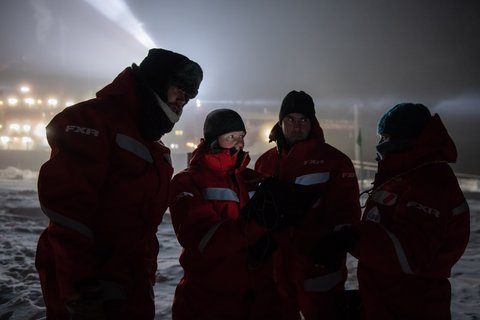
Team BGC science hand over between Leg 1 and Leg 2. BGC Leg 1 team member Dorothea Bauch (l) and BGC Leg 1 team lead Katarina Abrahamsson do a scientific hand over for BGC Leg 2 team member Adela Dumitrascu (r) and Partic Simoes Pereira (standing) execute the scientific hand over at BGC coring site on MOSAiC oce floe. (Photo: Esther Horvath)
14 Dezember 2019 (N86°36 E118°31)
First film shoots on German television
"Arktis-Expedition: Erste Filmaufnahmen der "Polarstern"
ARD's Tagesschau and Tagesthemen show the first films from the ice on the occasion of the UN climate conference COP25. (Das Erste, 14.12.19, 20:00 & 23:30)
https://www.tagesschau.de/multimedia/video/video-634023.html
12 Dezember 2019 (Madrid)
UN Climate Conference COP25
At the invitation of the BMBF, the German Pavilion at the UN Climate Conference COP25 hosted a side event entitled "Aerosol-Cloud Interactions in a Changing Climate: Opportunity or Threat". Experts connected by live transmissions to measuring stations at key locations on different continents and to the research vessel "Polarstern" in the Arctic presented the influence of changing air pollution on local weather and global climate change. We were also able to talk to our colleague Ronny Engelmann via satellite telephone.
More in German unter
https://www.fona.de/de/aktuelles/nachrichten/2019/aerosole_wolken_side_event_cop25.php
and English
https://www.tropos.de/en/current-issues/events-and-lectures/un-klimakonferenz-2019-cop25
10 Dezember 2019 (N86°32 E120°59)
„So you could almost call it North Pole .-)“
Shortly before the end of the first leg of MOSAiC we were able to talk to our colleague Ronny Engelmann on the Polarstern via satellite telephone on Tuesday evening. The 5min telephone call was a test for the live connection to observatories worldwide during the UN climate conference COP25 in Madrid, where on Thursday a side event will inform about the international lidar network PollyNet, the EU research infrastructure ACTRIS and the importance of short-lived climate drivers such as aerosols, clouds and trace gases.
Read the full text in German here:
https://www.tropos.de/aktuelles/messkampagnen/blogs-und-berichte/mosaic-2019-2020
8 December 2019 (Leipzig/Tromsø/Arctic)
New equipment and replacement on the road
Sensors for the big TROPOS tethered balloon “BELUGA“ on their way to MOSAiC
For the upcoming operations of the TROPOS tethered balloon “BELUGA” on the MOSAiC expedition from April to June 2020, instruments for the study of the atmospheric boundary layer in the Arctic are now on their way into the ice. The first supply vessel “Kapitan Dranitsyn” will bring the sensors for the measurement of aerosols, turbulence and radiation to the icebound Polarstern. The result of intensive developments at TROPOS is also present: the two, new platforms “CAMP 1 & 2”. With highly sensible instruments, they are capable to measure even lowest concentration of Black Carbon and other aerosol properties. Christian Pilz, TROPOS
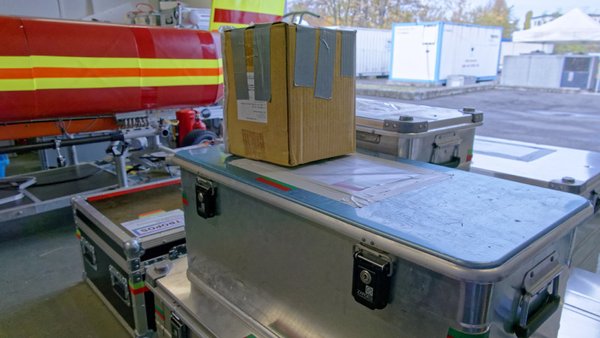
BELUGA equipment before transport. Photo: Tilo Arnhold, TROPOS
7 December 2019 (N86°9; E122°9)
Winter storms and complete darkness
"Up to and including yesterday, there was a strong wind here for a few days with snow drift and low visibility. To make work on the ice easier and to illuminate the way home, the three Polarstern spotlights are used". https://follow.mosaic-expedition.org/
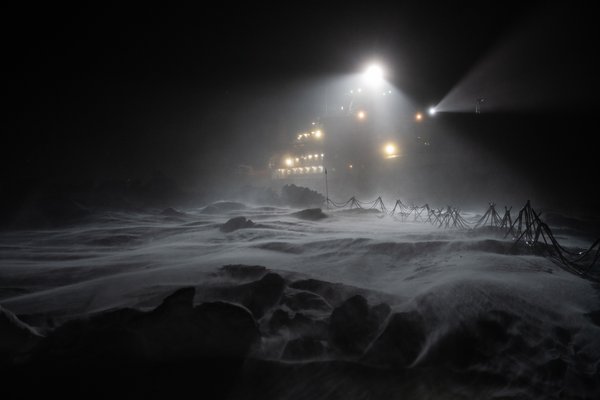
The Polarstern on Polar Night. In the meantime there is darkness around the clock. Until noon a hint of twilight can be guessed, it will take more than a month. But until the sun will show up on the horizon much longer. Temperatures fall below -30°C - in a snow storm with windchill effect far below -40°C. Photo: Esther Horvarth, AWI
6 November 2019 (N85°55; E116°43)
Work in polar night
"Our ship clocks are currently on UTC+8, which puts us seven hours ahead of Central European time. From now on we will reset the clocks every Saturday night until we reach UTC +3. This is Moscow time, after which the next supply ship, Dranitsyn, will be lived and worked on." https://follow.mosaic-expedition.org/
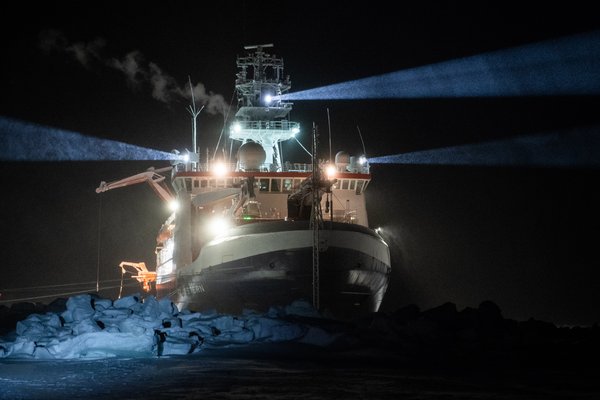
The Polarstern on Polar Night. The large on-board spotlights bring some light into the darkness. In front on the deck are various measuring containers, including the OCEANET container from TROPOS - recognizable by the green light of the laser reflected from the roof hatch of the container. The laser beam of the lidar itself is not visible because the air on the ground is very clean and the Polarstern's on-board headlights are much brighter. Photo: Esther Horvarth, AWI
25 October 2019 (N85°26 E127°50)
Polar Night & Weather
Polar Night
The polar night has arrived on the MOSAiC ice floe. Darkness characterizes the picture since the sun no longer comes over the horizon. Instead, there is very little residual light in the midday as in the homeland far after sunset at the end of twilight.
https://follow.mosaic-expedition.org/blog/mosaic_25-10-19/?lang=en
The floe is now drifting more and more northwest towards Spitsbergen: https://www.awi.de/fileadmin/user_upload/MET/PolarsternCoursePlot/psobse.pdf
What is the weather like on FS Polarstern in the Arctic right now?
The current data on temperature, precipitation and wind are now also available hourly from the Norwegian Weather Service - incl. forecast: https://www.yr.no/en/forecast/daily-table/0-82/Polarstern
Read more in the PolarPredictNews: https://www.polarprediction.net/news.html
These data come from the Polarstern on-board weather station, which is operated by the German Weather Service (DWD). The current weather data are also online
at the DWD https://www.dwd.de/DE/fachnutzer/schifffahrt/maritimberatung/mosaic/polarstern/polarstern_node.html
and AWI https://www.awi.de/nc/en/science/long-term-observations/atmosphere/polarstern.html
04 Oct 2019: MOSAiC expedition begins its ice drift on a floe at 85 degrees north and 137 degrees east
The MOSAiC team has now selected the floe that will serve as the base of operations for their one-year-long ice drift around the North Pole with the German research icebreaker Polarstern. This was preceded by an intensive search combining satellite imagery and helicopter flights over the target area in the Central Arctic, which were supported by the icebreaker Akademik Fedorov, operated by Russia’s Arctic and Antarctic Research Institute (AARI). The participating researchers closely examined 16 floes that, on the basis of satellite imagery, were potentially large enough to accommodate the ice camp. They subsequently met on board Polarstern to compare their findings, ultimately agreeing that the ice drift should be prepared for on a floe measuring roughly 2.5 by 3.5 kilometres, and located at 85 degrees north and 137 degrees east. The floe, which Polarstern will allow herself to become frozen to, is currently drifting in alternating directions, at up to 10 kilometres per day.
Read more: https://www.awi.de/en/about-us/service/press/press-release/a-fortress-of-ice-and-snow.html
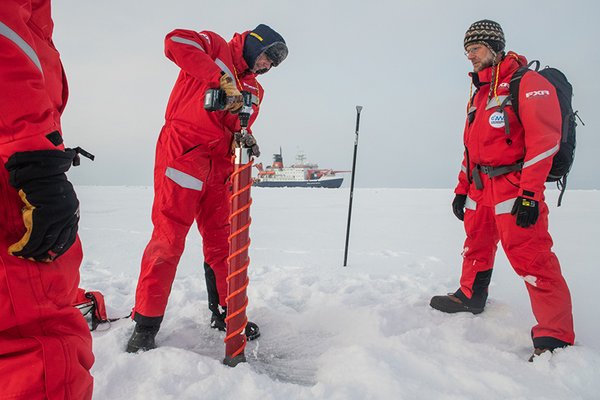
First group of scientists on ice floe (Photo: Esther Horvath, AWI)
22 Septemberg 2019: On the way to the pack ice
Polarstern is on its way to the northeastern Arctic. The preparations for the work on the ice floe are running at full speed during this transfer trip. At night, the Barents Sea offered spectacular views of northern lights, the Aurora Borealis:
https://follow.mosaic-expedition.org/blog/mosaic_22-09-19/?lang=en
"Anchors Aweigh for MOSAiC Leg 1" - first post in Polarstern blog by Marcel Nicolaus (AWI) from 22 Sep 2019: https://blogs.helmholtz.de/polarstern/en/2019/09/anchors-aweigh-for-mosaic-leg-1/
You can use the MOSAiC web app to follow Polarstern’s drift route live: https://follow.mosaic-expedition.org/
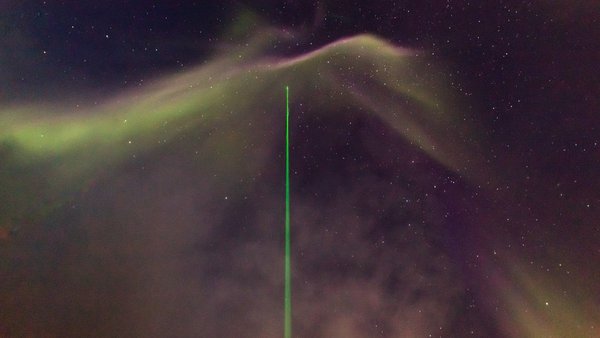
Foto: Alfred-Wegener-Institut / Stefan Hendricks
20 September 2019: Polarstern departure
News and media reports about the start:
Radio interview on detektor.fm with Prof. Dr. Andreas Macke, interview "Die größte Arktis-Expedition der Geschichte", 19-09-2019
Report in the Tagesspiegel, article "Eiskalte Forschung Warum Wissenschaftler den Winter in der Arktis verbringen", 18-09-2019
Report in the Sächsische Zeitung, article "Sachsen lassen sich am Nordpol einfrieren. Heute beginnt Mosaic, die größte Arktis-Expedition aller Zeiten. Sächsische Forscher sind dort mit dabei - und auch die SZ", 20.09.2019
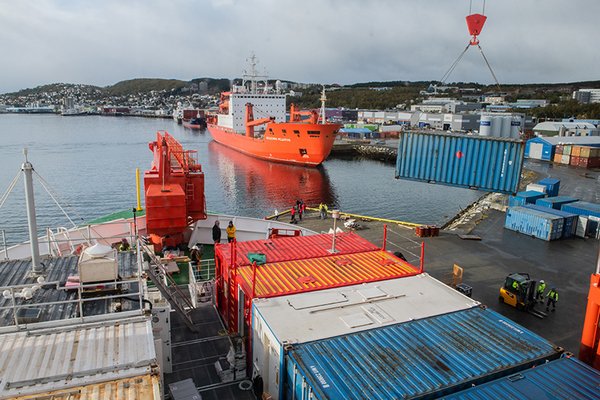
The last containers are loaded in Tromsö. The white OCEANET container from TROPOS (centre right) is already standing on the deck. Photo: Esther Horvarth, AWI
Transport of container & equipment on 26 August 2019
Here we go! Our OCEANET container with PollyNet lidar & other devices left Leipzig today. Destination: Tromsö.
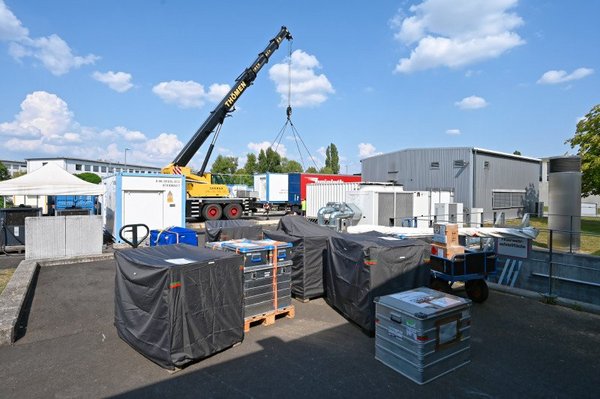
Photo: Tilo Arnhold, TROPOS
Preperations
The Leibniz Institute for Tropospheric Research (TROPOS) will play a leading role in two central measurements of the MOSAiC campaign: Firstly, the OCEANET remote sensing container will continuously explore the vertical aerosol and cloud distribution for the entire ice drift using lidar, radar and microwave radiometers. On the other hand, a 90 cubic metre tethered balloon on sections 4 and 5 will bring several measuring devices up to 1500 m altitude in summer 2020 in order to measure the Arctic boundary layer as precisely as possible. TROPOS will also be integrated into the expedition leadership of section 5: The expedition leaders for this section will be Prof. Dr. Dieter Wolf-Gladrow from AWI and TROPOS Director Prof. Dr. Andreas Macke.
see press release from 27 June 2018
From mid-January to mid-February 2019, a field campaign was conducted at the TROPOS Melpitz station near Torgau to prepare for the MOSAiC expedition.
see report of the campaign from February 2019 and video on the test campaign by MDR Wissen
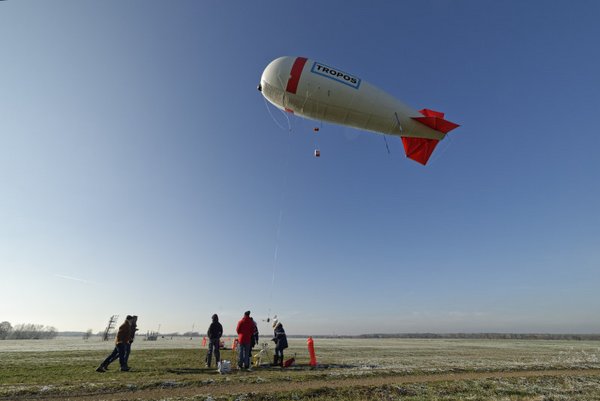
In winter, the Leipzig team tested in Melpitz the assembly and disassembly of the tethered balloon including the attached measuring technology. (Photo: Tilo Arnhold, TROPOS)
For one year frozen in the Arctic ocean
It'll be the biggest Arctic expedition ever: Starting in autumn 2019, the German research icebreaker Polarstern will drift frozen through the Arctic Ocean. On the MOSAiC expedition, scientists from 19 nations will explore the Arctic over the course of the year. They spend the winter in a region that is almost inaccessible at polar night. The natural force of the ice drift alone gives this unique opportunity. A research camp will be set up on an ice floe and connected to a kilometre-wide network of measuring stations.
Hardly any other region has warmed as much in recent decades as the Arctic. Therefore the aim of the expedition is to better understand the influence of the Arctic on the global climate. This milestone for climate research and its data will be valuable for generations to come. The mission led by the Alfred Wegener Institute is associated with unprecedented challenges. An international fleet of icebreakers, helicopters and airplanes supplies the team on this extreme route. This expedition can only succeed with joint efforts.
Trailer MOSAiC expedition by Alfred Wegener Institute
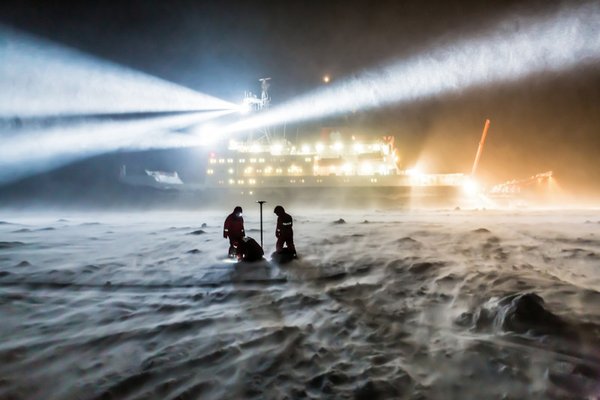
Stock photo (Polarstern expedition ANT-XXIX/6 2013): Alfred Wegener Institute/Stefan Hendricks